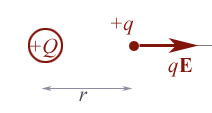 A
small test charge $q$ in the field of a source charge $Q$ at origin feels a
force $$\myv F = k\frac{qQ}{r^2}\uv r.$$
A
small test charge $q$ in the field of a source charge $Q$ at origin feels a
force $$\myv F = k\frac{qQ}{r^2}\uv r.$$Reading: Chapter 23, ELECTRIC POTENTIAL
Study guide: Chapter 24
Topics:
The gravitational force between two point masses is $\propto 1/r^2$ and is conservative (can be derived from a potential energy), so it seems reasonable that since the electric force between two point masses $\propto 1/r^2$, that it too should be conservative, and can be derived from a potential energy. We'll find this energy by integrating the dot product of force and displacement: $dW=\int \myv F\cdot d\myv l$.
 A
small test charge $q$ in the field of a source charge $Q$ at origin feels a
force $$\myv F = k\frac{qQ}{r^2}\uv r.$$
A
small test charge $q$ in the field of a source charge $Q$ at origin feels a
force $$\myv F = k\frac{qQ}{r^2}\uv r.$$
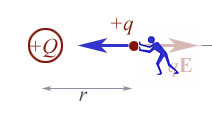 But
if an external agent (let's call him "Joe")
pushes on the charge, he exerts a force exactly opposite to the one the charge
feels.
But
if an external agent (let's call him "Joe")
pushes on the charge, he exerts a force exactly opposite to the one the charge
feels.
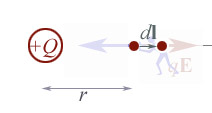 Consider
the work done when moving the charge by $d\myv l$ from $x=r$ to $x=r+dl$. Is
it $dW= qE\,dl$ or $dW= -qE\,dl$?
Consider
the work done when moving the charge by $d\myv l$ from $x=r$ to $x=r+dl$. Is
it $dW= qE\,dl$ or $dW= -qE\,dl$?
Well, what both points of view could perhaps agree on is that when two like charges are further apart, there is a lower potential energy. In the picture, $\myv E$, and $d\myv l$ are both pointing in the positive $\uv x$ direction, so $\myv E \cdot d\myv l \gt 0$. So, to make the change in energy come out right, we need to have
$$ U(\myv b)-U(\myv a)= -\int_{\myv a}^{\myv b}q\myv E\cdot d\myv l.$$
Two points of view are possible, though the potential remains the same:
Now, the electric potential (just like E vs F) is some characteristic of space that depends only on the source charges and not the test charge: $$\begineq\Delta V&\equiv&\frac{\Delta U}{q} = -\frac{1}{q}\int q\myv E\cdot d\myv l\\ &=& -\int \myv E \cdot d\myv l.\endeq$$.
[Electric field between 2 flat plates with a potential difference of 10 V separated by 2 mm? We will shortly see that the electric potential (watch out for just "potential"!) on a conductor is everywhere the same....]
In polar coordinates, the position of our test charge is $(r,\phi)$. But for the field $\myv E(\myv r)=E_r(r)\,\uv r$ of a point charge, the dot product depends *only* on the distance $r$ and not the angle $\phi$, so $$\begineq \Delta V = V(\myv b)-V(\myv a) &=& -\int_a^b q\myv E(\myv r)\cdot d\myv l = -\int_{\myv a}^{\myv b} \frac{kQ}{r^2}\,dr\\ &=&+kQ\[\frac{1}{r_b}-\frac{1}{r_a}\].\endeq$$
What is the reference point for potential? It's arbitrary...all we can measure is differences in the potential between two points. So we will define the reference location to be $V(r=\infty)=0$. So, to calculate the potential near a point charge $Q$ we set
$$\Rightarrow V(\myv r) = \frac{kQ}{r}.$$
A positron (anti-electron) is moving at a speed of $6 \times 10^6$ m/s towards a far-off, slow-moving $\alpha$ particle. What is the closest the two particles can get to each other?
Many particles instead of just one? Think about integrating the net electric field from point charges...
$$\begineq V(\myv r) - V(\infty) &=& -\int_\infty^{\myv r} \myv E_\text{net}(\myv r)\cdot d\myv l \\ &=&\int_\myv{r}^\infty \myv E_\text{net}(\myv r)\cdot d\myv l\\ &=&\int_\myv{r}^\infty \left(\myv E_1(\myv r)+\myv E_2(\myv r)+\myv E_3(\myv r)+...\right)\cdot d\myv l\\ &=&\int_\myv{r}^\infty\myv E_1(\myv r)\cdot d\myv l+\int_\myv{r}^\infty \myv E_2(\myv r)\cdot d\myv l+\int_\myv{r}^\infty\myv E_3(\myv r)\cdot d\myv l+...\\ &=& V_1(\myv r) + V_2(\myv r) +V_1(\myv r) +...\\ V(\myv r) &=& \frac{kQ_1}{r_1} + \frac{kQ_2}{r_2} + \frac{kQ_3}{r_3} + ...\endeq$$
Where $r_3$ is the distance from charge 3 to $\myv r$, etc.
[Find the potential on the perpendicular bisector between two point charges...]
[You can also do integrals...]
Show that all the points in a conductor must be at the same potential by integrating the field from $a$ to $b$.
$V=\int_\myv{r}^\infty \myv E\cdot d\myv l$ and $V=\sum \frac{kQ_i}{r_i}\to\int \frac{k\,dQ}{r}$.
Aw, Let's just go hiking instead!
Earth's landscape is actually an energy landscape: Gravitational potential energy = $mgh$. So, the earth's landscape is a "graph" of $U \propto h$ where $U(x,y)$ is a function of two coordinates.
On a contour map of the landscape, points of equal height (equi-height-als) are connected by contour lines.
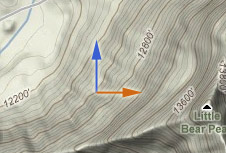 $\frac{\del
h}{\del x}\equiv$ slope (change in height 'rise' / 'run') as you move
east (no
change in north/south direction). Is this positive or negative in the picture?
$\frac{\del
h}{\del x}\equiv$ slope (change in height 'rise' / 'run') as you move
east (no
change in north/south direction). Is this positive or negative in the picture?
$\frac{\del h}{\del y}\equiv$ slope as you move north (with no change in the east/west direction). Is this positive or negative in the picture?
[If $h(x,y)=13y^2(x^2-1)$, what is the slope in the $x$-direction at (2,1)? That is... $\del h/\del x$?]
See these visualizations of partial derivatives and directional derivatives.
 How would you figure out in which direction the slope is greatest?
How would you figure out in which direction the slope is greatest?
It
ought to be somewhere between:
We also probably ought to weight the direction more towards either $x$ or $y$ depending on which slope (partial derivative) was greater.
So, how about...
$$\frac{\del h}{\del x} \uv{x} + \frac{\del h}{\del y} \uv{y} \equiv \myv{\grad} h.$$ The gradient.
This vector, the gradient turns out to have all of these characteristics:
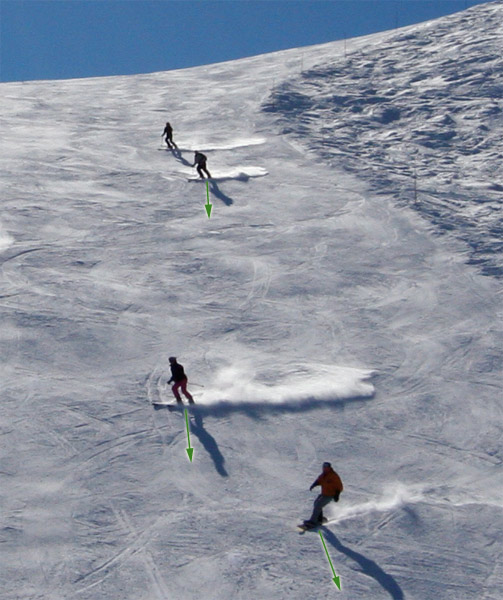 Skiers
talk about a "fall line"-the direction
of steepest descent,
Skiers
talk about a "fall line"-the direction
of steepest descent,
or the direction that water would flow away from a particular point on the mountainside. $-\myv{\grad} U$ points in the direction of the fall line. (Though, if we're picky, it doesn't actually point "down" the mountain slope, only points in the same $x$-, $y$-direction of the fall line, but with no $h$-component).
If we start hiking, by how much will our altitude $h$ change? Call the change $dh$. The change of height will depend on...
[As long as we take small steps, the slope is not changing very much.]
$$dh=\frac{\del h}{\del x}dx+ \frac{\del h}{\del y}dy=\myv \grad \cdot d\myv l.$$ Since $d\myv l = dx\,\uv x + dy\, \uv y+ dz\, \uv z$.
Now, apply this to....$$V=-\int \myv E \cdot d\myv l$$ where the displacement $d\myv l = dx\,\uv x + dy\, \uv y+ dz\, \uv z$
....
We conclude that $$\myv \grad V = \myv E$$
and in terms of components... $$E_x = -\frac{\del V}{\del x}$$ $$E_y = -\frac{\del V}{\del y}$$ $$E_z = -\frac{\del V}{\del z}$$
[Find the direction, approx magnitude of the electric field from a contour map of $V$, or equation for $V$ of ...]